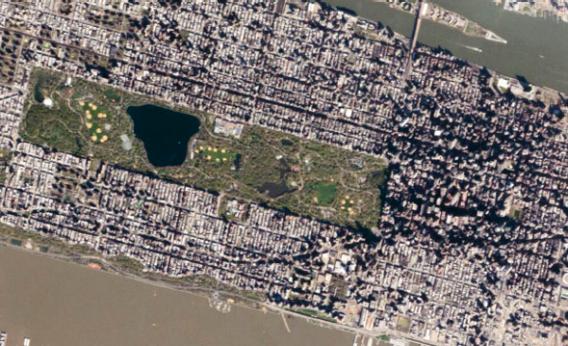Create a free profile to get unlimited access to exclusive videos, sweepstakes, and more!
If You Get Caught Between the Moon and New York City

I post a lot of pictures from space, because I love ‘em. I usually focus on remarkable natural formations, weather patterns, volcano eruptions, and the like. I don’t generally post recognizable human-made landmarks—the natural Earth is usually cooler than anything we humans can do—but I can’t resist this one.
I assume most folks will recognize it: That’s Manhattan, one of the boroughs of New York City. It was taken on May 5, 2014, by an astronaut on board the International Space Station as it passed high over the Big Apple. The full-resolution image is pretty amazing; you can easily pick out individual buildings, boats, and more.
A few things struck me. The East River (top) is a different color than the Hudson (bottom). I suspect this has to do with suspended sediment flows being different in the two rivers, but I wonder if their being polluted in different ways has something to do with it.
I also really like the part of the picture showing the area around Central Park. The buildings to the south (in Midtown) give the picture a bumpy feel, and their shadows make that area of the city look dark, even at midday. The buildings are crowded together, so even when the Sun is near its maximum height for the day, the shadows cast can stretch for a long way. That plays havoc with temperatures and winds; I’ve been in that area on windy days and the channeling effect can really whip up a decent gust.
When I see Central Park I’m always surprised at how big it is. I got turned around in there once and it added several kilometers to my walk! It’s also dotted with huge granite boulders, and I remember seeing grooves and troughs carved into some of the rocks in the park, clear signs of ancient glaciation. Kids were playing on the rocks, and I remember smiling, thinking that if they only knew how much truly ancient history was right beneath their feet.
The dark, wavering line to the west (near the bottom of the picture) is the New Jersey Palisades, a series of basalt cliffs that date back to the Mesozoic. They’re really quite beautiful, and I always think of them (and the huge groves of pink and white blossoming peach trees to the north) when people make fun of New Jersey.
I’m not much of a city guy, to be honest; while I love visiting bustling metropolises, I prefer to live in the quiet of the countryside. But when I see something like this from space, it reminds me that humans have a huge variety of tastes and preferences, and that’s wonderful. It’s also a reminder that despite being small, and living on a vast planet, we have the ability to profoundly change it to suit our needs … and that sometimes that change winds up not suiting our needs. I’m fine with growth, expansion, and modification, as long as it’s done with an eye toward the environment, and the future of humanity itself.
Correction (June 29, 2014 at 03:00 UT): I originally wrote that the Palisades were to the south, but being in New Jersey, they are toward the west of NYC.














